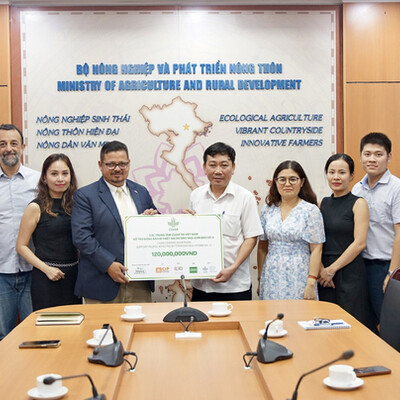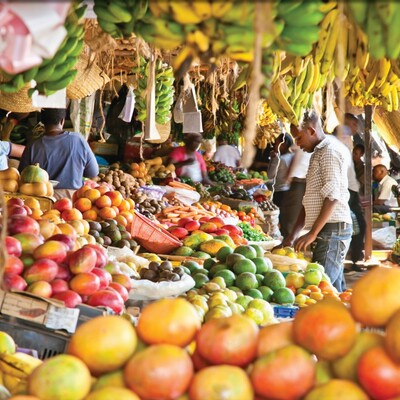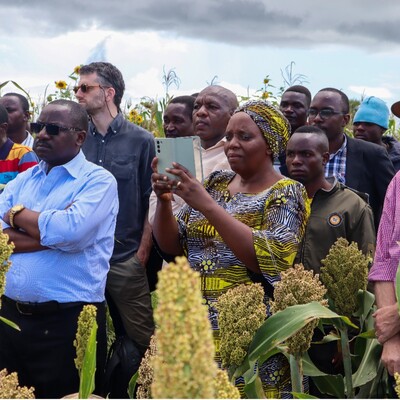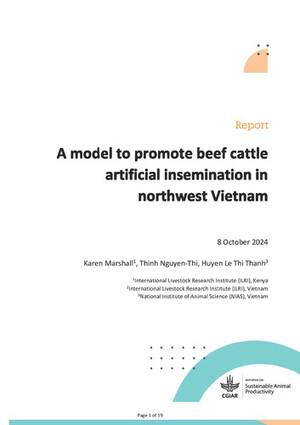
The power of ideas: New ways of thinking about gender can improve development outcomes
 What does it mean to take gender seriously in development—and specifically in agriculture and livestock development? How can the international community promote economic development in ways that are both culturally sensitive and substantively equitable? What kinds of power are available to women in various cultural and economic contexts and how can these be reinforced? Alessandra Galiè, an anthropologist and senior social scientist at ILRI, has been researching answers to these questions for decades, both at a theoretical level and in the context of specific development projects focused on food, nutrition and livestock value chains. She is the principal author of the Women’s Empowerment in Livestock Index (WELI), an index used to assess the empowerment of women in production systems in which livestock are important. She holds a PhD from Wageningen University and an MA in social anthropology of development from the University of London. Recently Alessandra sat down with ILRI editor David Aronson to discuss her latest work (with co-author Cathy Farnworth), on a new way to conceptualize gendered power relations, which they call ‘Power Through.’
What does it mean to take gender seriously in development—and specifically in agriculture and livestock development? How can the international community promote economic development in ways that are both culturally sensitive and substantively equitable? What kinds of power are available to women in various cultural and economic contexts and how can these be reinforced? Alessandra Galiè, an anthropologist and senior social scientist at ILRI, has been researching answers to these questions for decades, both at a theoretical level and in the context of specific development projects focused on food, nutrition and livestock value chains. She is the principal author of the Women’s Empowerment in Livestock Index (WELI), an index used to assess the empowerment of women in production systems in which livestock are important. She holds a PhD from Wageningen University and an MA in social anthropology of development from the University of London. Recently Alessandra sat down with ILRI editor David Aronson to discuss her latest work (with co-author Cathy Farnworth), on a new way to conceptualize gendered power relations, which they call ‘Power Through.’

Gender scientist Alessandra Galie (photo credit: ILRI/Apollo Habtamu).
David: First, before we get into the substance, let me congratulate you on the branding: That’s an excellent term, ‘Power Through’. It sounds like you are set to be endorsed by a sports drink!
Joking aside, this isn’t just another way of saying we should remember to consider women’s perspectives as we design development interventions, is it? It has a much more specific and substantial meaning. Can you explain, very briefly, what the term means?
Alessandra: I’ll be sure to get Nike involved!
So what is power through? Basically in the literature about gender and empowerment, there are four underlying concepts about what power is and how it is exercised. And what we’ve done is we added one more concept. So to summarize a vast literature, very briefly, when we talk about power what we mean first of all is power within, in terms of yourself, of self-confidence and ability to, for example, set your own goals. Second is power with, which is when you just intentionally team up with somebody else. For example, you have a couple of cows, but you don’t produce enough litres of milk to make it worthwhile for a company to come to your farm to collect them. So you go to your neighbour and you say, ‘Let’s team up, pack the milk together, and then a company may be more interested in working with us’. Third is the power to, the power to get something done. And finally, of course, there’s what we think of when we think of power, which is the power over someone. Sometimes that last one has negative implications, but not necessarily.
So these are the four standard meanings of power people use to discuss empowerment. Typically, you say empowerment starts with power within. There’s this ontological or internal transformation about coming to realize that you may have aims in your life or goals, and then understanding that you actually have a right to be able to get to that goal. And then there is the power to do something for example, the freedom to collaborate. So if you want to get to that goal, then you team up with other people and so on.
Now to these four forms of power, we added a fifth, which is power through. This concept resulted from a lot of the fieldwork that I’ve been doing on empowerment since 2006 and the work that my colleague Cathy Farnworth has done on empowerment, also.
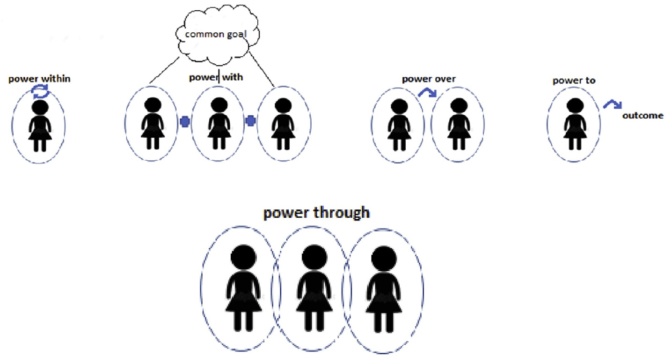
Power through, visualized (Image credit: Alessandra Galiè)
David: Yes, you’ve been doing this for a while …
Alessandra: And in all the analysis that we’ve read, all the discussions we’ve had, there was always this one bit that wasn’t formulated. It wasn’t there. There was something missing. So at one point, we thought, okay, let’s sit down and think this through. And what we realized was missing is the idea that empowerment is not just a property that I possess, but is interlocked with the empowerment of others. One blunt example is if you are connected to a powerful person. Say you are a young village boy and your mother becomes the mayor. You yourself haven’t really done much – or been able to do much – in terms of improving your power—you may not have gotten an education, or formed an association for advancing a cause—but just by default, because you are the son of a mayor, you are now significantly more empowered than you were (e.g. in terms of how visible you are, how much weight your opinion has in the community etc). It’s an involuntary kind of empowerment.
David: So if I understand you, this concept sort of straddles or at least touches on two different literatures. One is the literature of individual agency. And the second is a more explicitly feminist literature about people living within gendered social structures that affect their ability to influence outcomes.
Alessandra: Absolutely, yes. So you raised two important points. One is the issue of agency. Because an objection some people may have to the concept of power through is that without agency there can’t be empowerment. For example, the distinguished social economist Naila Kabeer says that agency is necessary for empowerment to be actualized. And that makes complete sense. Yet, we would add that the empowerment literature includes some ‘preconditions’ for empowerment which are not necessarily agentic. These include, for example, your social background or your education that influence the ‘power within’… which is to say there are characteristics that support or undermine your ‘potential’ to realize your empowerment. Similarly, the non-agentic dimension of the power acquired by simple association to significant others creates the preconditions for ‘potential’ empowerment. So, the paper came out of this need to identify something, as I said, that really didn’t have a name.
David: Once you articulate an idea, it suddenly becomes visible. You can start seeing it everywhere, even in places you weren’t looking.
Alessandra: You know, a lot of people have had similar experiences, where you try to articulate what is going on within a body of evidence, but also speak to some of the current trends in the literature, in this case, empowerment. This paper was born out of trying to articulate this body of evidence, but also in a way, speaking to some of the current trends in empowerment such as our current attempts at measuring empowerment quantitatively. We’ve developed the Women’s Empowerment in Livestock Index, the WELI. This tool was developed with a very sound theoretical basis, and a very sound raison d’etre: the need to quantify changes in empowerment, for empowerment to ‘formally’ enter the development agenda.
David: Right, what you can’t measure can’t be seen.
Alessandra: Exactly, that’s the usual argument. So it’s very good that there is a tool to quantitatively assess empowerment, so you can assess progress, report on it, get funding, and so on. But precisely because we were ourselves involved in the development of one of those quantitative tools, we realized that the tools had shortcomings. We were trying to quantify something which is extremely vague, extremely intangible and so on. One of the issues we confronted is that the standard way of measuring the empowerment of women in quantitative tools creates an opposition vis-à-vis the empowerment of the men in the household. If one’s empowerment goes up, the other’s has to go down. And what we realized is that one person’s empowerment is actually interlocked with the empowerment of others. So we are trying to work past this either/or man versus woman dynamic or zero-sum conceptualization of empowerment.
David: Right. It’s not a zero-sum.
Alessandra: Exactly. It is interrelational because there is an overlap in power. So how do we measure things that overlap and dynamically feed into each other? These feedback loops can be negative too. To give you an example, we worked with this young woman from Syria. She came to a conference, an international labour conference, and she left the meeting feeling completely empowered. She has been exposed to an international community. She’d been on the stage talking….
David: And suddenly, after the conference, she’s back in her home environment.
Alessandra: The community had been negatively judging her travel, because there was no man supervising her. So when we talked to her in Aleppo, at the conference, she started feeling really empowered. But when she went back to the community, the community completely isolated not just her, but also her whole family. Nobody was paying visits anymore. People were really strongly criticizing her brother and so on. So when she went back home, the reality was she was more disempowered than ever. So we have to think of power not just in terms of how people think of themselves, but of how the community acknowledges or demeans your status, because it’s through them that the power becomes real. The key point here is that empowerment only exists in the daily lived experiences of individuals who are affected by local norms. So regardless of how much a woman seems empowered to us because of our WELI scores, if her behaviour is not compatible with local gender norms, she will experience disempowerment. So, again, how do we develop measures that are able to capture that?
David: And how do you advance change, except through individuals, if the problem is at a community level?
Alessandra: Yes. So you need to measure empowerment based on how the community judges the household, as well as how it judges individuals within the household. And maybe you need to involve the community in the empowerment of some of its members. That’s an important point, one that is often neglected in the discourse about women’s empowerment. We will fail at empowering women if we focus solely on the women: we have to focus on the broader ways that communities and societies construct gender. How do we involve others in supporting women’s empowerment vis-à-vis local norms?
David: And too often the focus of many development projects is simply on helping women out, right—on for example improving their economic standing?
Alessandra: In one project in Tanzania, for example, we had a lot of women talk to us about the fact that we had created interventions that involved giving them ownership of dairy cattle and control over milk revenues. And as a result, they felt empowered. However, soon after the women had the ownership of the animals and the control over the produce and the revenues, they started seeing how the men felt. The men got really upset. They felt their traditional role as ‘bread-winners’ was undermined. They stopped contributing to the family income, and in many cases, they left the household. The whole community judged the men negatively for not being able to keep control of the household and the women for not being ‘good wives’ (by letting the men take all decisions). And therefore, the women felt that the community was judging them very negatively for having embarrassed their husbands publicly. Also, they lost the financial support of the husbands and were left alone to look after the children. And as a result, they came to feel disempowered. So the lesson is that if you are trying to address women, to enhance women’s empowerment, and you don’t look at this wider gender dynamics, you will undermine your own efforts. Doing women’s empowerment without understanding the gender dynamics and addressing those may undermine what you’re doing. It is not going to work.
David: Interesting. Okay, so the obvious question is, what do you do? How can you intervene at that level, in a way that doesn’t produce more pushback?
Alessandra: One approach that we see too often is that you address women in your projects, but then you try to make it right by bringing in the men and trying to convince them to support the women. That’s not enough. For me, it is really about gender dynamics. How does an intervention interact with local gender dynamics? Actually trying to understand what the gender dynamics are here. So we have, for example, a project in Ghana on animal vaccines. We are trying to make the vaccine system there more gender responsive, with both accommodative and transformative approaches. So we talk to the community about their perception of who is a vet, about who they regard as knowledgeable or competent. Can women be vets, can they be considered trustworthy, knowledgeable vets? And so in our intervention, we try to support women with a gender approach.
David: I guess I feel ambivalent about that. On the one hand, it’s vital to take community standards seriously, to be attentive to local values and cultural realities. On the other hand, isn’t there a risk that you end up endorsing or supporting the very values that you wish to challenge?
Alessandra: You know, for me, these issues can’t be sidestepped. All projects are gendered, just by the choice of which animal species to work with, which vaccines to work with, which crop, which breeds and so on – you are improving the domain of one gender rather than the other. So even when you are trying to be narrow and technical in your decisions, your interventions will probably target one group rather than another. Or one activity rather than another. So projects are gendered by their very nature, even if not by design.
David: Without necessarily thinking it through…
Alessandra: Absolutely. And so when we talk about gender, gender analysis, gender equity, a lot of people will critique us for wanting to “change” the communities. And my response is, whatever we do – even if we simply introduce a new goat vaccine – will bring change to communities. We may simply not pay attention to this change, but we do bring change. So it’s better to be aware of this, and then engage with the project first, to question our own gender assumptions, and the with the community to understand how the project interacts with the local gender dynamics, and what would make it work or not, and work for whom. Engaging the community in this kind of common effort to improve their lot.
David: But how do you do that? How do you engage the community, in a way that doesn’t backfire?
Alessandra: Well, again, going back to this project in Ghana (we have other projects in Ethiopia and in Tanzania), for example, we are trying to engage the community in dialogues, really sit down with them, and try and discuss the issues. In Ghana, we have this issue of women’s limited mobility to get the vaccines. Women have goats and chickens, but they are discouraged from taking public transport to go to the vet, and they’re discouraged from interacting with the vet, who is usually a man. So you need to develop a whole system to bring the vets to the women through their husbands, to bring them access to animal health. So one approach is, Okay, let’s address the root causes. Let’s discuss with the community why it is that women can’t move: What’s the issue? What’s the problem? Why can’t women ride a bike to get to the vet? What do you think is the issue here? Do you think it would be good if they could ride a bike? Would it undermine men? Why would it do that?
So we try to engage the community and think through some of these norms. Because these norms are so integral in their lives and in our lives. They’re so integral we don’t see them anywhere unless someone raises the issue, points them out, questions them.
David: I imagine it isn’t easy to have these conversations. People tend to be either unconscious or hypocritical about issues having to do with gender or sex. I mean—all of us, not just some.
Alessandra: Sometimes when you get in a community, if you ask the community whether they need to discuss gender issues, if there are any problematic gender issues in the community, people, women and men mostly say no, we have no gender issues here. And that is part of the problem. If people were aware, then we probably wouldn’t have all these issues, right? So there is a moment where I think we need to go in with a project that isn’t direct and invasive. We can’t go in, as we sometimes do, demanding that the community address gender issues—because that’s not going to work and we can’t know in advance what change the community wishes and how to achieve it. We need to go in saying, ‘We have a project that works, that helps people by providing them with a new vaccine for instance, but we want to do it with a gender awareness. And then we engage the community and find out what the issues are and work on solutions with them. And I’m saying this, because we had a project where we looked at gender dynamics in informal milk trading. We found very strong norms affecting the lucrativeness of the business for women and young men, as compared to older men. The latter were able to earn much more. We developed a gender-responsive intervention based on the findings and went back to the community for validation. The community leaders listened to us and then said they had no gender issues there and therefore there was no need for a gender-responsive intervention.
David: In the article, you have an interesting phrase I want to ask you about. The ‘gender norms façade’. Can you talk a little bit about what that is?
Alessandra: Let me start by telling a story. I was working with this woman, also a Syrian. She was in a household where the parents were very old. And so they were not involved in agriculture anymore. They were just sitting at home, very old. And her brother was younger, but he was living in Lebanon. She was the oldest daughter. And women didn’t really have many opportunities in Syria before the war, so she was the one who was looking after the farm. When I asked her who makes decisions about the farm, she told me, It is my brother. And then I asked her about that: What do you mean your brother makes the decisions? He lives in Lebanon. Yes, she said. So how often does he come back home? Once a year. So do you make phone calls? No, we don’t make phone calls.
So by this point, I was puzzled: Okay, I told her, help me understand. You say that he makes the decisions about the farm but he’s never around. So we kept going back and forth with this, with me trying to understand. And finally, I asked her, Okay, what happens if your brother takes a decision you don’t agree with, given that you’re running the farm? She said, He never does. I said, How come he never takes a decision you don’t agree with? She says, because once a year, when he comes home, before taking any decisions he first asks me what I think, what I think is a good way forward. I tell him, and then he takes the decision.
David: Clever!
Alessandra: Suddenly, it was all very clear to me. She was using what we named in this article norms façade. She was saying, everything is totally standard here, we’re all following the rules—while in fact, she was running the show. And the community respects her both for running the farm and for not violating these rules. Whereas the other woman from Syria, the one I mentioned at the beginning of this interview who attended that international conference, she has suffered for violating them. Her brothers were the ones who paid the highest price. They were young, the father was dead, so they got blamed for her behaviour. It’s not a simple morality play, where the men are just bad. It’s just that they are held responsible for their sister’s behaviour. So if the community thinks that a woman has misbehaved, the blame goes on the woman first, but also on the man or men who are viewed as responsible for her. So, all these issues, you know, get very complex very quickly and we can’t fail to capture them if we truly want to enhance women’s empowerment.
Alessandra and Cathy Rozel Farnworth hosted a webinar in November 2019 on the CGIAR Collaborative Platform for Gender Research discussing these concepts in more depth. Their full paper can be accessed here. Their presentation can be accessed on SlideShare here.








